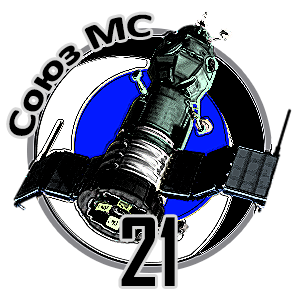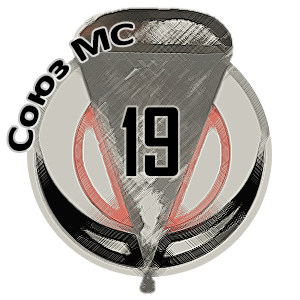
I was weightless...
German MAX Cover September 2004
by Alexander Böker (D) September 2004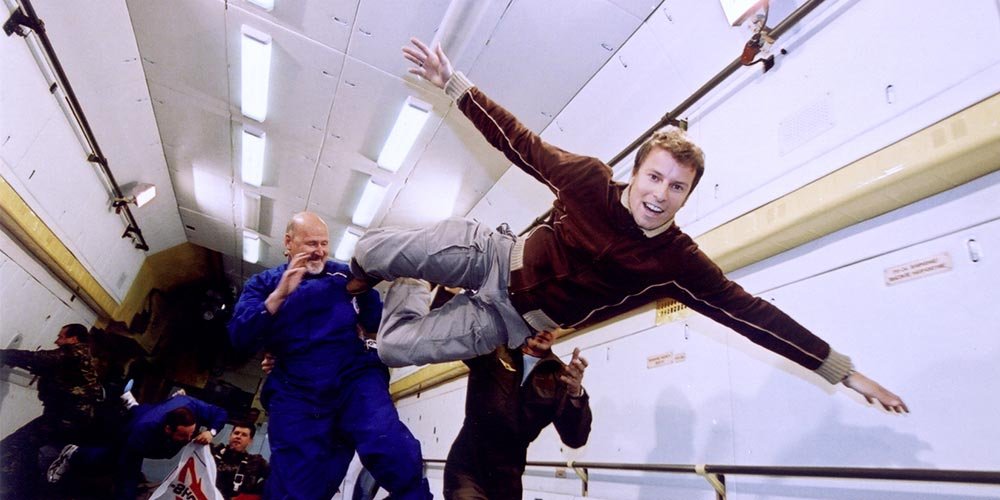 No drug of the world can shift one into the condition of absolute weightlessness. No, who wants to fly as in the dream, must drive to Moscow and rise into the Cosmonaut Trainings Centre of Star City, the GCTC. Then, he has to go inside an Ilyushin 76 MDK, which some people called 'the vomit bomber'.
No drug of the world can shift one into the condition of absolute weightlessness. No, who wants to fly as in the dream, must drive to Moscow and rise into the Cosmonaut Trainings Centre of Star City, the GCTC. Then, he has to go inside an Ilyushin 76 MDK, which some people called 'the vomit bomber'.
It is as in an American war movie: We sit in the cargo bay of an air freighter, and we were flown to the target area. The first mission. In Hollywood, there would be a close-up of the faces now. All are silent. Strained silence.
Nevertheless this gladly times, I would say a word now: My parachute cuts me into the shoulders. The thing is much more heavily than I had thought, dearest I secretly the belts would loosen. But the Chief Instructor, which looks like a third Klitschko brother, would not permit that certainly. Thus: Teeth together! Silence. The way in the target area cannot be so far any longer.
 Some participants of the zero-g flight with Andreas P. Bergweiler
Some participants of the zero-g flight with Andreas P. BergweilerWe are in a Russian Ilyushin 76 MDK. A four-jet, large transportation machine with a span of more than 50 meters. It smells insides a little as in a gym hall at school. The soil of the loading space is lined with soft, dark-green mats. There! Few edges of old marks. Determined only watermarks? Or? Fast enough to move the eyes away from this. There is a kind command condition at that the cockpit turned side: loud instruments, switches, printers and small lamps. Otherwise nothing. No windows, no seats, no hostesses, no snacks. Those would be a little attached.
We are on the way into weightlessness. There is somebody, whose stomach becomes lighter also. Our group: a hand of fully space-crazy Germans and a married couple from Poland, probably also space-crazy. The youngest of us go still to the school, the oldest is a pensioner. We are all checked at home from a physician, before we were leaving Germany and other countries, and before we could have the famous 'Zero-G Certificate' in our hands. Experts say "Zero-g flight", because the force of gravity, physically G, is here occasional zero (thus "zero"). A Zero-g flight is not anything for people, who are sitting over the whole day in armchairs, nothing for 'soft eggs'. You have to be in the right fitness conditions.
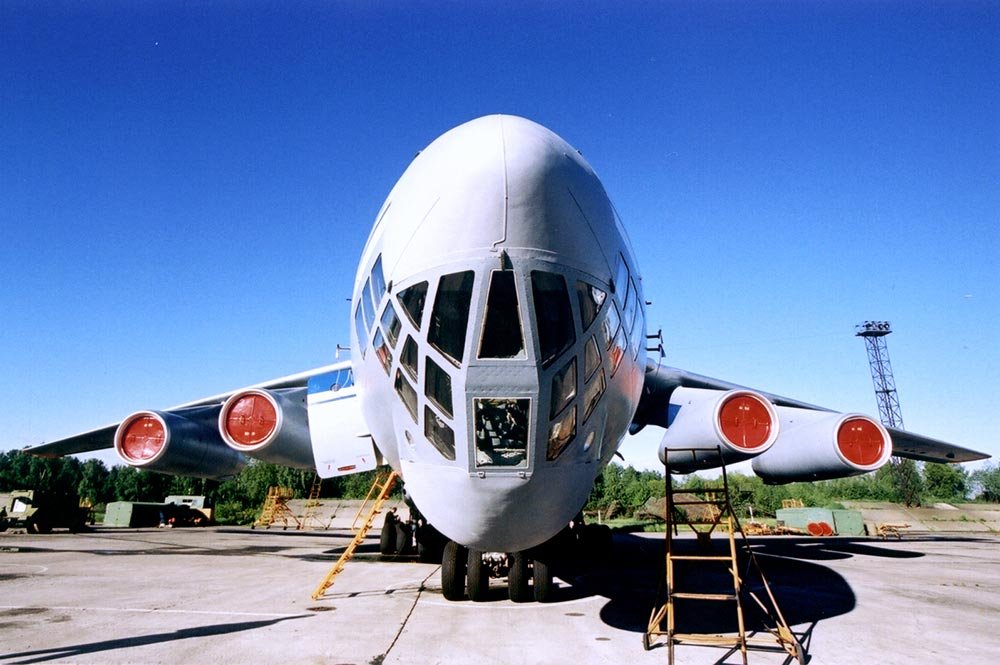 The front of the Ilyushin 76MDK of the Gagarin Cosmonaut Training Center
The front of the Ilyushin 76MDK of the Gagarin Cosmonaut Training CenterYou are fit. You are fit. You are fit. Am I fit? The word chains rotate in my head. Andreas, our Zero-g experienced group leader, said yesterday: One must get involved in weightlessness. And little a self-confident its also needed. Then it goes very well with the stomach.
Two days before we had arrived a good bus hour far away from Moscow and northeast from there to Star City. In a nearby fir forest, the centre of Russian space flight hides. Since 1966 here are trained all cosmonauts. Star City looks like as if possibly that somehow threw onto the with asphalted some hands entirely yellow multistoried latch plates into the forest. 6500 humans are living here, technicians, scientists, physicians, beginning cosmonauts, cosmonauts in the retirement and the American Greg Olsen. He has to pay 20 million $US for a tourist flight in the universe, and he is here since months and trained his step out the yard. The children of the city don't want to be a firefighter or become a nurse, they want to fly into space. They learn from the beginning of the second school-class English. Few of them could work it out.
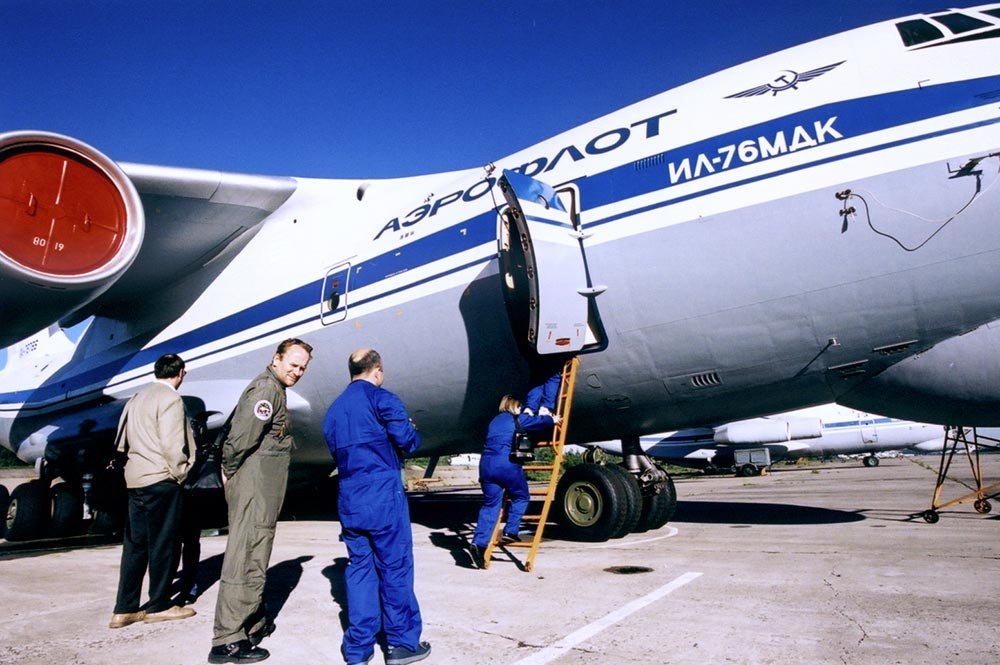 The boarding begins
The boarding beginsAt the moment, 39 student-cosmonauts trained six and a half long years for to be a real cosmonaut. Then fly - perhaps.
The Russian Space Agency has not enough money. Therefore Star City offered Zero-G flights for tourists. Russia sent only 98 humans into the universe - thus rather few compared - with the 272 US astronaut. But Russians spent more than five times as much time as the Americans in the world, 'do you have understood this, yes?', the Russian guide had explained, a resolute lady of the appearance of a Mireille Mathieu (French singer) aged in speed of light, she had led us to through the strictly guarded area of Star City.
The most famous inhabitant of the city was called Juri Gagarin and flew as the first human to the universe. That was 1961. Gagarin is pervasive. He stands as an enormous statue at the first large crossing of Star City, and he lives in the heads of the native ones. Besides, he has its own museum, in which moreover many artefacts from Russian space travel is issued. Something of these items belongs to Juri Gagarin: his fired wallet. 1968 Gagarin died in a flight accident. "Unfortunately", Mireille Mathieu had said, "Gagarin was looking very expressed, and he was a handsome man." In the museum, still another photo hangs beside the wallet: three trees, whose treetops looked like cute - the place, at which his MIG went to the soil. There we fly exactly now:
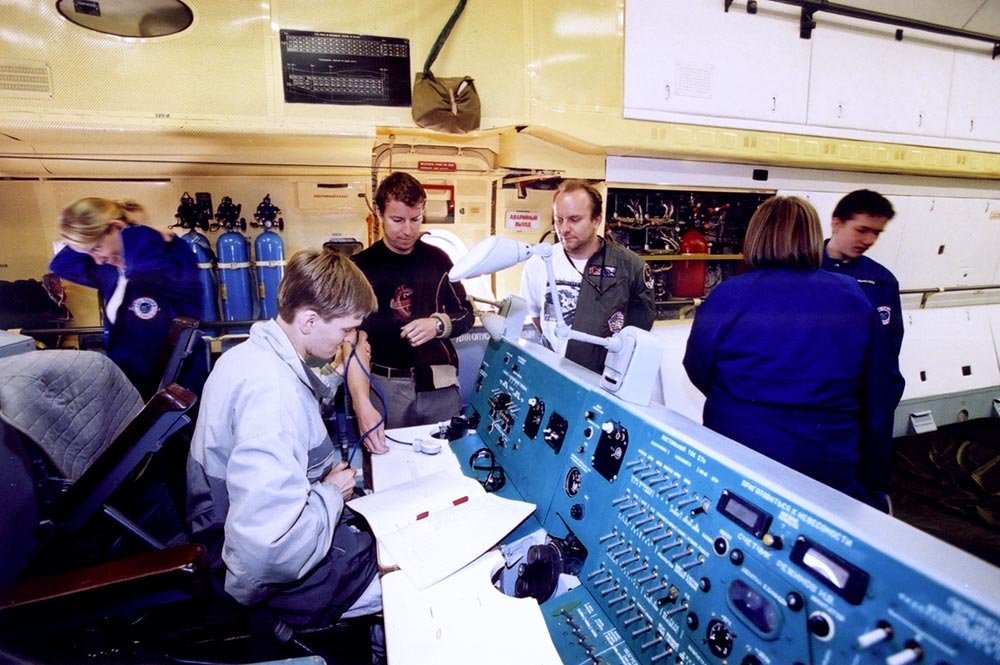 Last medical check-up before the flight
Last medical check-up before the flightInside Ilyushin, with well 750 kilometres per hour. The Russians still practice over the same area test at once. Northeast from Moscow, an air space of 2000 x 2000 kilometres is approved to use by the military for everything, which is elsewhere strictly forbidden. Zero-g flights for example also called parabola flights.
During a parabola flight, the aeroplane rises with an angle from 45 to 50 degrees into the sky, from 6000 to 9500 meters altitude. The pilot takes the throttle away above and lets the aeroplane tip. Then in the same angle again 3000 meters against the earth. Later the pilot intercepts and changes some seconds the machine again into the straight flight. Up to the next parabola. In the period between full throttle, taking away the throttle and intercepting, there is absolute weightlessness to about 25 to 30 seconds inside the aeroplane. Humans in the aircraft fall just as fast towards the soil as the aeroplane. You can buy this adventure, for example with offerers such as Space Affairs on the Internet. And in such a way I sit now, in the midst of my small German/Polish travel's group, in the full loading space of a Russian jet and wait for the astronaut feeling.
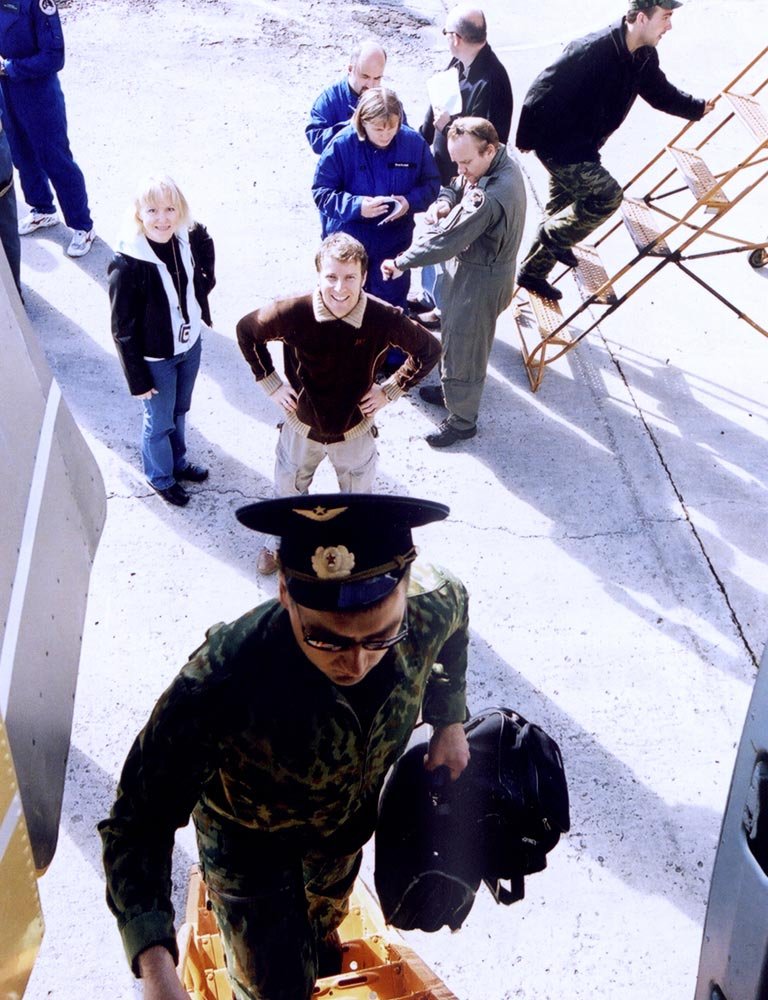 The captain of the Ilyushin 76MDK comes onboard
The captain of the Ilyushin 76MDK comes onboardA parabola flight is aeronautically very fastidious. A pilot steers thereby only the hight-rudder, another just the side rudder. And naturally, substitutes stand ready if possibly one of the personnel become consciousness (which never happens). Besides, there is a physician on board and seven instructors so mentioned, through-trained Russians, Cosmonaut Trainer. Andreas had said at the day before You have to follow their instructions. One of the instructors shows us special signs, that means for us now: We can remove the parachutes, which are prescribed when starting. I feel incomprehensibly less bulky already now. The instructors show us, how we are to get over the first parabola: sitting on the soil, the backs to behind. We hold on to a bar, which runs along like a railing at the inner aeroplane wall. Group parabolaThen everything goes very fast. The manoeuvre begins with little stalling. Two seconds the feeling, which one knows from the car if one drives very fast over a hilly road. The aeroplane lowers the nose completely briefly, around momentum to take up for the climb.
Then it goes uphill. The engines roar. Strange to say thereby, the aeroplane soil seems to me in no way bent and it slips despite the 45-degree angle, also not all humans fell into the rear aeroplane part. But on my side, so far, I feel an utterly unknown power, a strength presses me to soil. As a monster jumped on my shoulders. It seems to me in such a way, as if even the meat of my cheeks moved towards soil; I can keep the head upright to mine, it twice as heavy hardly - in the climb 2 G, the second terrestrial attraction force prevails. And then becomes it track-send brightly.
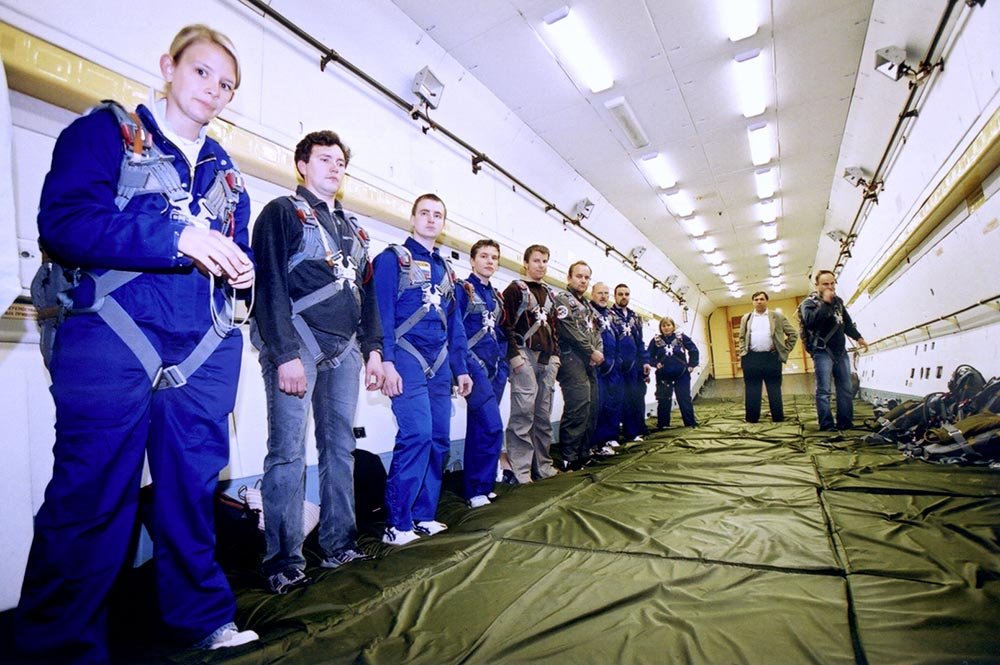 The flight participants with their rescue parachute systems before the zero-g flight
The flight participants with their rescue parachute systems before the zero-g flightThe spotlights in the loading space signals: Zero-g. My blood, which had driven the force of gravity evenly still into my toes, rushes now back into my head. But which is that? My legs are completely easy, where are all my legs? There are them. Before me, over me! That cannot be, that these are my legs! Yes! I keep still the bar clasped and turn inexorably upward - where is actually above if there is none down? -, until I make hand conditions on the bar. I want again back, but I cannot steer. Swimming movements do not use anything in weightlessness. Everything is easy. So incomprehensibly easily. It is so beautiful, I could die for now! But I do not die. From the loudspeakers the instructors instead in hard Russian ordered, to pick us again from the roof to the soil. I hardly lie on the mat, intercept the pilot the machine, and I have pressed again with two G on the ground. The wings of the Ilyushin - I have heard later - to bend itself with this manoeuvre in each case three and a half meter through, like bamboo in the wind. After some seconds we fly again straightforward. My first parabola is ended.
Short self-check. Pulse: accelerated. Stomach: stable. Brain: as on drug. What for hell was that?
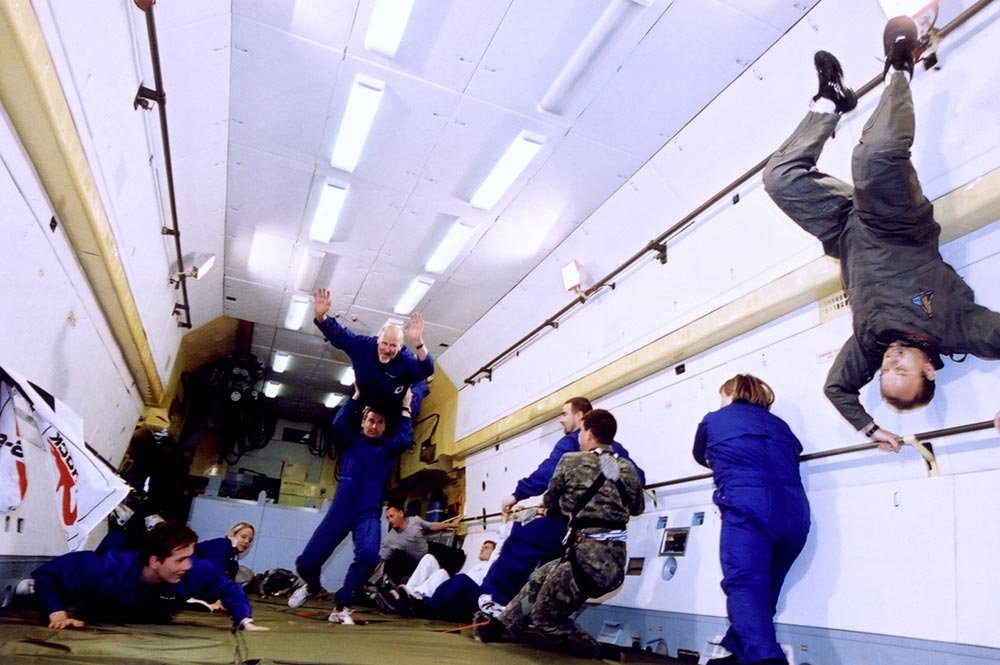 During the Zero-G flight in a parabola
During the Zero-G flight in a parabolaThe second parabola. All become more courageous, up to Poland, which uses their bags however very shy. Again, the blood rushes at the beginning in my ears. Again everything becomes easier. It is the same feeling, which one has in the aeroplane if the holiday jet flies through turbulence. Also sometimes there it pulls to one for a lash impact to the cab cover. During the parabola flight, this feeling increases in the infinite. I am completely weightless. During this, I use the time to look around me. The others catch on to float, the instructors their feet in loops on the soil hooked. Dust grains stand before me in the air. I repel myself from the wall, fly to the cover, repel me again and stick to the other wall. An instructor pulls me back down. How quickly, please, do 30 seconds pass? Still, eight further parabolas we fly, then the pilots break off: A gale approaches. I ran on the cover, made salt, an instructor have mean bodies shifted and then like a cannonball by the area shot me in the rotation. I flew with spread arms, as in the dreams of my childhood. I was weightlessly like humans in the universe; I have shouted out because of luck. And, no, I did not vomit. It was not even dangerous for me. On the return flight again all are silent. The Polish people exhaust their vomit bags. In quiet euphoria, we lie on the soil and hardly notice that those remounts Ilyushin sometimes on the earth. Now we still down-climb the ladder, purely into the bus and from the airfield directly in the hotel. There I fall asleep, for several hours, in the bright afternoon. My body is at the end. When I was waking up, there was a question jumped through my brain: How long will I remember? How long my muscles and my nerves will forget? To the feeling, to be forced only by my mind and without heaviness? I have to go up there again!
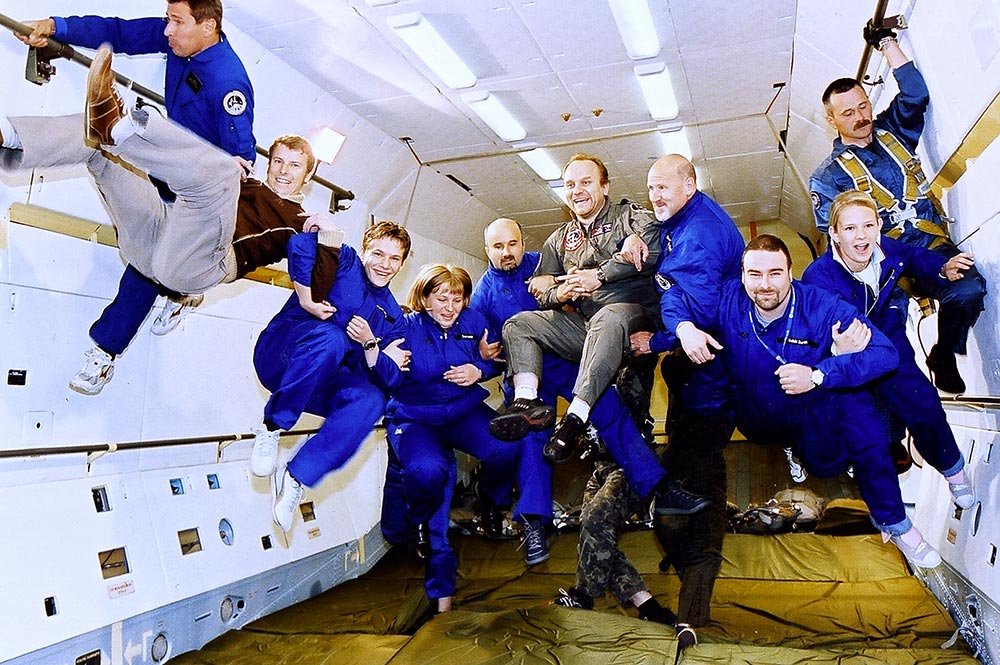 Fun in Zero-G!
Fun in Zero-G!Who completes a space training as German in Russia, does not go past at him: Andreas Bergweiler, 39. Bergweiler applies for us in Europe and a worldwide scene of the space travel-inspired as light shape - as the man with the big dream Bergweiler was the first civilian at all, who was allowed to participate in a Russian cosmonaut training: he practised 2001 with cosmonaut landings in the water. Since then, he has a few dozens of parabola flights behind himself, a centrifuge training and a High Altitude flight, with which one ascends with a jet on 29 kilometres height - to the edge of space.
From there one sees Earth's curvature, and the sky is black. Since Star City opened the gates also for foreigners, Bergweiler is a gladly seen guest there - and whenever a German travel's group booked a space experience, Bergweiler participates as a competent guide. And each day in the cosmonaut training centre takes him nearer a step to his big dream: to the flight in the universe, dearest in a Soyuz spaceship to the International Space Station ISS, on the traces of space tourists, such as Dennis Tito or Mark Shuttleworth, or - Juri A. Gagarin.
However: There are missing the necessary 20 million dollars. From the essential training, Bergweiler completed most anyhow. Now the sponsor is only missing. "Sometimes", he, and he is sure, " recognises someone that how perfect for an advertisement figure a private man is who is up to fly to space. A normal guy!"
Text © Copyright Alexander Böker - leading editor/department leader of 'Modern life' of the magazine MAX
Photos © Copyright Arne Müller
Photographer Arne Müller (l) and Author Alexander Böker (r) wonder about dark stain on the soft matting.
The report appeared in the MAX 'BIG' expenditure on 23.09.2004.

